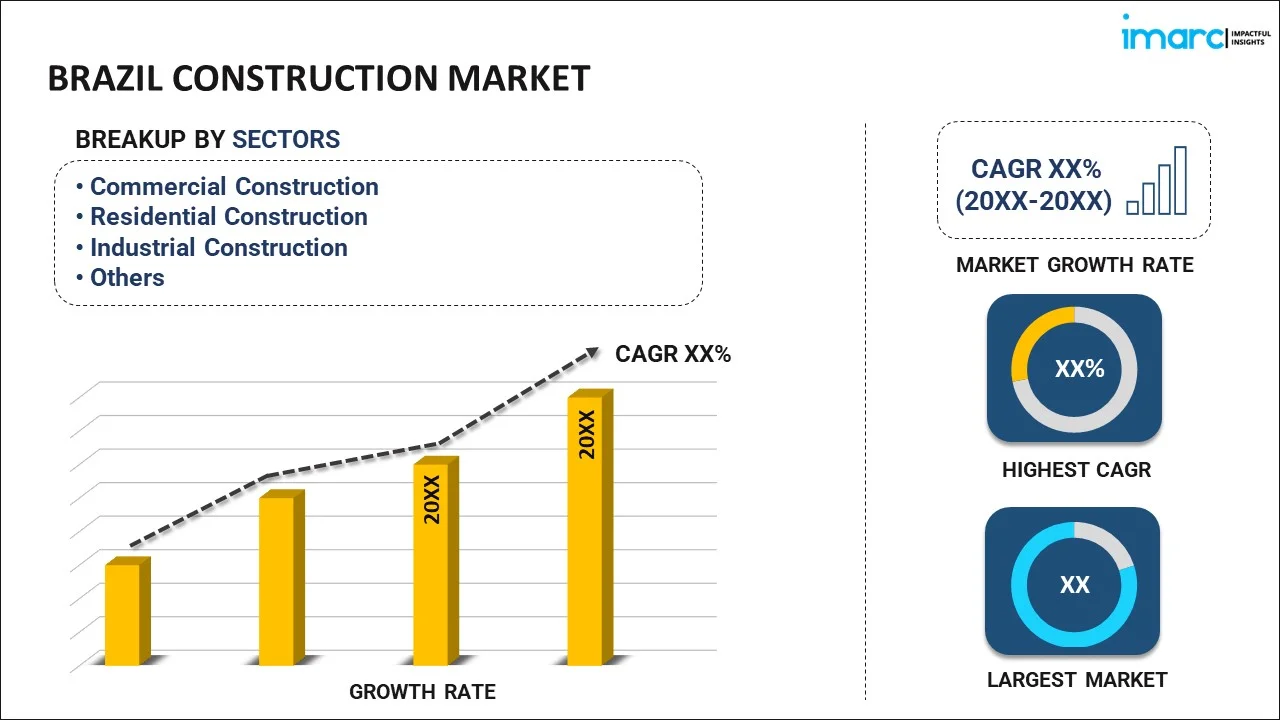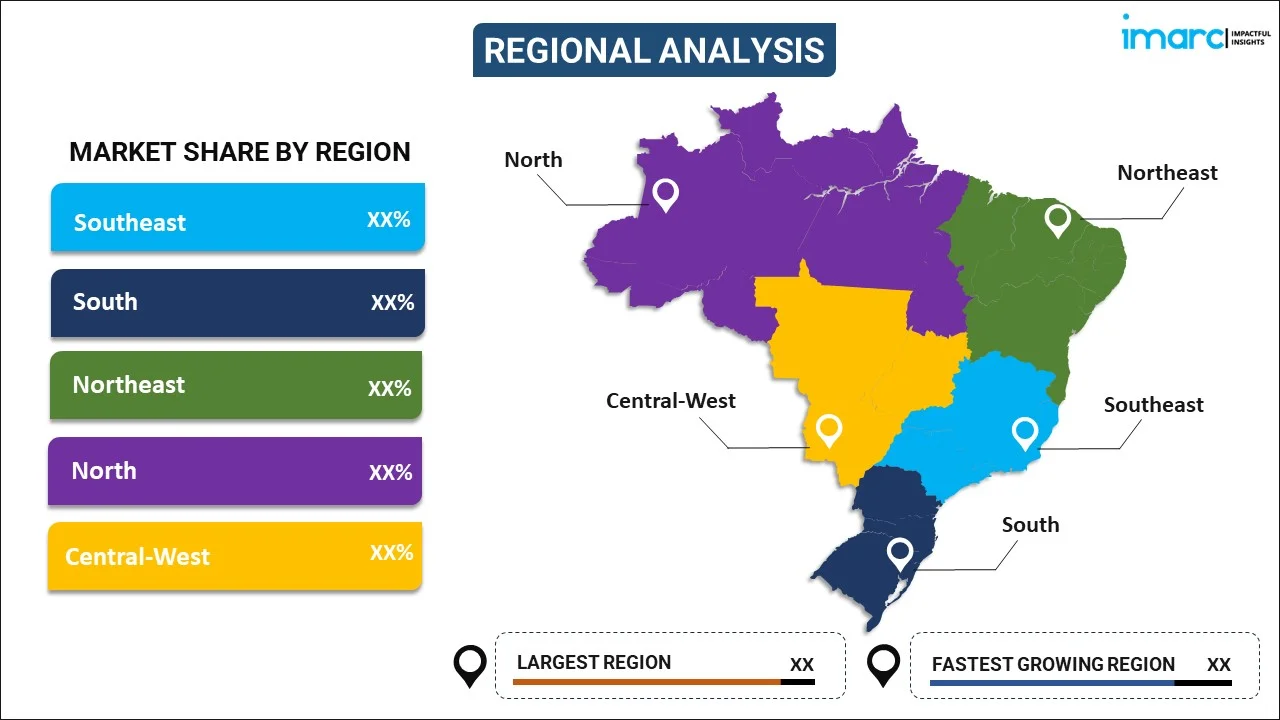
Brazil Construction Market Report by Sector (Commercial Construction, Residential Construction, Industrial Construction, Infrastructure (Transportation) Construction, Energy and Utility Construction), and Region 2026-2034
Market Overview:
Brazil construction market size reached USD 156.0 Billion in 2025. Looking forward, IMARC Group expects the market to reach USD 218.2 Billion by 2034, exhibiting a growth rate (CAGR) of 3.80% during 2026-2034. Expanding infrastructure development, urbanization, rising demand for residential and commercial properties, government initiatives, and ongoing technological advancements represent some of the key factors driving the market.
|
Report Attribute
|
Key Statistics
|
|---|---|
|
Base Year
|
2025 |
|
Forecast Years
|
2026-2034
|
|
Historical Years
|
2020-2025
|
| Market Size in 2025 | USD 156.0 Billion |
| Market Forecast in 2034 | USD 218.2 Billion |
| Market Growth Rate (2026-2034) | 3.80% |
Construction is a multifaceted industry encompassing the planning, design, and physical creation of structures, infrastructure, and facilities, essential for shaping the urban landscape and supporting economic development. It involves the meticulous coordination of labor, materials, and equipment to construct buildings, roads, bridges, and other essential components of modern society. The construction process begins with project conceptualization and feasibility studies, followed by architectural and engineering design. Subsequently, construction teams execute the plans, ensuring adherence to safety regulations, quality standards, and project timelines. Construction is an intricate network of various stakeholders, including contractors, subcontractors, architects, engineers, and project managers, all working cohesively to bring projects to fruition.
Brazil Construction Market Trends:
Organization, Housing, and Tech Push Ahead
Increasing urbanization, expanding infrastructural development, and rising demand for residential and commercial properties, are primarily driving the market growth. In line with this, numerous government initiatives and extensive investments in infrastructure development projects, such as transportation networks, energy facilities, and public utilities, are propelling the market forward. Moreover, Brazil's government's extensive efforts to host international shows, such as the FIFA World Cup and the Olympics, have spurred building construction activities, creating a favorable outlook for market expansion. At the same time, the flourishing expansion of the manufacturing, healthcare, and tourism industries, as they require modern facilities and infrastructure, is contributing to the market growth. Concurrently, the rising focus on sustainability and environmental considerations leading to the adoption of green building standards and environmentally friendly construction practices is aiding in market expansion. Besides this, extensive investments in real estate by domestic and international entities, especially in cities like São Paulo and Rio de Janeiro, are supporting the market growth. Moreover, the surging need to modernize aging infrastructure, encompassing roads, airports, ports, and utilities, to enhance connectivity and stimulate economic growth is acting as another growth-inducing factor. In addition to this, Brazil's persistent housing deficit, especially in low-income segments, combined with numerous government programs and incentives facilitating the development of affordable housing projects is bolstering the market growth. Furthermore, the escalating adoption of technological advancements, such as building information modeling (BIM), prefabrication, and automation enhancing efficiency, reducing costs, and improving project timelines, are presenting lucrative opportunities for market expansion. Apart from this, Brazil's open-market policies attracting foreign direct investment (FDI) and fostering international collaboration in construction projects, are providing an impetus to the market.
Infrastructure Investments Boosts Construction
Large-scale spending on transport, energy, and sanitation networks is giving the Brazil construction industry a solid lift. Improvements to ports, roads, and rail lines are easing cargo movement, strengthening domestic trade routes, and opening export opportunities. Expanding the reach of electricity grids ensures more reliable power, supporting businesses and communities alike. Upgrades in sanitation help raise health standards and support new urban developments. These improvements attract investors looking for stable, long-term projects and give construction firms steady work pipelines. The ripple effects extend to material producers and local suppliers who benefit from larger orders and consistent demand. Jobs created by these undertakings help local economies, offering incomes for thousands. With clear commitments to infrastructure, Brazil is laying groundwork for smoother logistics, healthier cities, and stronger competitiveness, keeping the construction equipment sector busy and vital for the country’s progress.
Industrial Expansion Drives Construction Demand
Growth across Brazil’s industrial landscape is keeping construction companies busy with new projects. As local manufacturing ramps up in areas like food processing, cars, and green energy, new plants, warehouses, and distribution centers are needed to handle higher output. Many businesses are upgrading old sites or launching building construction to reach higher productivity levels and meet international requirements. These investments often come with new roads, utilities, and worker accommodations, adding more work for builders and engineers. Policy support and investor confidence in Brazil’s production capabilities are encouraging more companies to expand operations within the country. This shift toward domestic production helps cut supply chain risks and brings extra work for contractors who specialize in complex industrial builds. All these factors mean building and construction activity remains a strong pillar for the wider market, supplying consistent projects and helping Brazil grow its position as a regional manufacturing base.
Urban Growth Increases Housing Needs
Rising city populations in Brazil are putting pressure on housing supply, driving steady activity in the residential construction market. Families continue to move into major cities, adding to the need for apartments, condominiums, and planned communities. Many developers are launching projects to meet the demand for affordable and mid-range homes, helped by favorable financing options and government support for first-time buyers. Changing lifestyles and incomes are shifting what people want in a home, with buyers looking for secure, well-located spaces with modern comforts. Builders are responding with taller buildings, mixed-use projects, and communities with better access to schools and transport. As urban centers keep expanding, the housing sector provides a dependable flow of contracts for developers, material suppliers, and construction workers alike. The ongoing demand for new homes keeps residential building a reliable part of Brazil’s wider construction machinery market.
Brazil Construction Market Segmentation:
IMARC Group provides an analysis of the key trends in each segment of the market, along with forecasts at the country level for 2026-2034. Our report has categorized the market based on sector.
Sector Insights:

To get more information on this market, Request Sample
- Commercial Construction
- Residential Construction
- Industrial Construction
- Infrastructure (Transportation) Construction
- Energy and Utility Construction
The report has provided a detailed breakup and analysis of the market based on the sector. This includes commercial construction, residential construction, industrial construction, infrastructure (transportation) construction, and energy and utility construction.
Regional Insights:

- Southeast
- South
- Northeast
- North
- Central-West
The report has also provided a comprehensive analysis of all the major regional markets, which include Southeast, South, Northeast, North, and Central-West.
Leading Construction Companies in Brazil:
The market research report has also provided a comprehensive analysis of the competitive landscape in the market. Competitive analysis such as market structure, key player positioning, top winning strategies, competitive dashboard, and company evaluation quadrant has been covered in the report. Also, detailed profiles of all major companies have been provided. Some of the key players include:
- Andrade Gutierrez
- Constran Internacional
- Grupo Agis
- Mendes Júnior Engenharia SA
- MRV
- Polimix Concreto
- Teixeira Duarte
(Please note that this is only a partial list of the key players, and the complete list is provided in the report.)
Brazil Construction Market Recent News:
- June 2025: Brazil launched a USD 10 Billion plan funding over 120 roads, ports, and waterways to connect South America and the Caribbean. This boosted the construction market by driving new contracts, improving trade routes, and attracting private and foreign investment partnerships.
- May 2025: Brazil confirmed plans with Russia’s Rosatom to build small modular nuclear reactors. This project strengthened Brazil’s energy infrastructure, supported cleaner power in the Amazon, replaced fuel oil plants, and opened new opportunities for specialized construction and engineering firms nationwide.
- March 2025: Gerdau opened a new hot-rolled steel line in Ouro Branco, Minas Gerais, adding 230,000 Tons of capacity annually. The USD 260 Million project modernized facilities, strengthened local steel supply for the automotive and machinery sectors, and supported Brazil’s construction material availability.
- September 2025: Entrevias began building a 2.4 km Tiete River bridge under the SP-333 expansion in São Paulo. This project doubled crossing capacity, created over 500 jobs, boosted regional transport for agriculture and tourism, and strengthened Brazil’s construction market.
Brazil Construction Market Report Coverage:
| Report Features | Details |
|---|---|
| Base Year of the Analysis | 2025 |
| Historical Period | 2020-2025 |
| Forecast Period | 2026-2034 |
| Units | Billion USD |
| Scope of the Report | Exploration of Historical Trends and Market Outlook, Industry Catalysts and Challenges, Segment-Wise Historical and Future Market Assessment:
|
| Sectors Covered | Commercial Construction, Residential Construction, Industrial Construction, Infrastructure (Transportation) Construction, Energy and Utility Construction |
| Regions Covered | Southeast, South, Northeast, North, Central-West |
| Companies Covered | Andrade Gutierrez, Constran Internacional, Grupo Agis, Mendes Júnior Engenharia SA, MRV, Polimix Concreto, Teixeira Duarte, etc. |
| Customization Scope | 10% Free Customization |
| Post-Sale Analyst Support | 10-12 Weeks |
| Delivery Format | PDF and Excel through Email (We can also provide the editable version of the report in PPT/Word format on special request) |
Key Benefits for Stakeholders:
- IMARC’s industry report offers a comprehensive quantitative analysis of various market segments, historical and current market trends, market forecasts, and dynamics of the Brazil construction market from 2020-2034.
- The research report provides the latest information on the market drivers, challenges, and opportunities in the Brazil construction market.
- Porter's five forces analysis assist stakeholders in assessing the impact of new entrants, competitive rivalry, supplier power, buyer power, and the threat of substitution. It helps stakeholders to analyze the level of competition within the Brazil construction industry and its attractiveness.
- Competitive landscape allows stakeholders to understand their competitive environment and provides an insight into the current positions of key players in the market.
Key Questions Answered in This Report
The Brazil construction market is expected to grow at a CAGR of 3.80% during 2026-2034.
Brazil’s construction market has grown due to city population growth, big upgrades in roads, ports, and energy, plus strong demand for homes and factories. Public funding, private investors, green building standards, and digital tools like BIM have kept projects moving nationwide.
The pandemic slowed building work through material shortages and site shutdowns but pushed new spending plans and more housing starts. Remote work changed design needs, boosting demand for home spaces and logistics hubs. Despite early setbacks, infrastructure and housing needs revived market activity.
Based on the sector, the Brazil construction market has been segmented into commercial construction, residential construction, industrial construction, infrastructure (transportation) construction, and energy and utility construction.
On a regional level, the Brazil construction market has been segmented into Southeast, South, Northeast, North, and Central-West.
Some of the major players in the Brazil construction market include Andrade Gutierrez, Constran Internacional, Grupo Agis, Mendes Júnior Engenharia SA, MRV, Polimix Concreto, Teixeira Duarte, etc.
Need more help?
- Speak to our experienced analysts for insights on the current market scenarios.
- Include additional segments and countries to customize the report as per your requirement.
- Gain an unparalleled competitive advantage in your domain by understanding how to utilize the report and positively impacting your operations and revenue.
- For further assistance, please connect with our analysts.
 Request Customization
Request Customization
 Speak to an Analyst
Speak to an Analyst
 Request Brochure
Request Brochure
 Inquire Before Buying
Inquire Before Buying




.webp)




.webp)












